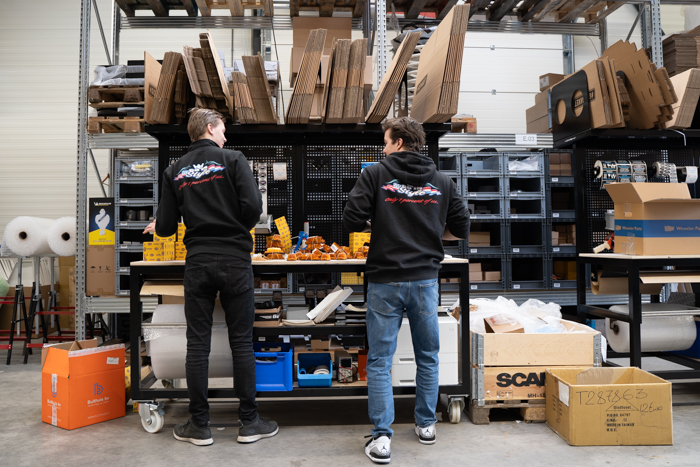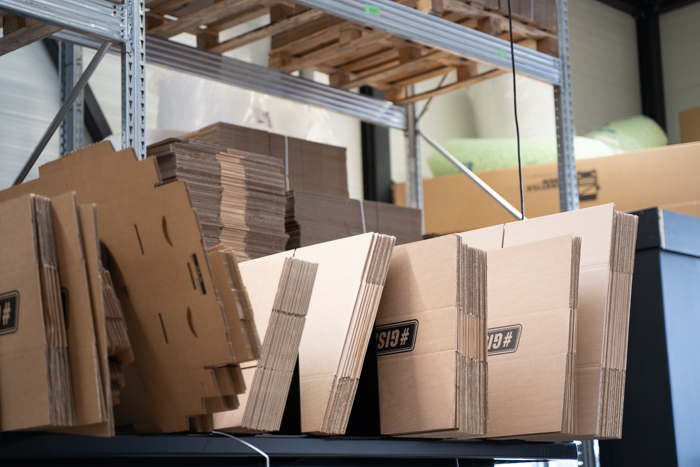5 practical tips for your packing table
The packing table is a key part of the process from order to shipment. It’s where you prepare and pack all your orders for delivery. Since you repeat these tasks many times throughout the day, a fast and neatly packed parcel leads to happy customers. To work efficiently, it’s essential that your packing table is clean, comfortable, and easy to work at. In this blog, we share 5 practical tips for setting up your packing table so every package goes out perfectly.
Tip 1: Start with a solid and modular system
Choose a packing table that fits your product range and needs. Make sure you can choose from a wide range of interchangeable parts, such as storage bins, shelves, and racks. This allows you to expand or adjust the table at any time as your assortment or workflow changes. It doesn’t really matter where you buy your packing table, as long as the materials are high quality. Your table will be used intensively. A strong tabletop that can withstand bumps and scratches will last you a long time.

Tip 2: Create a comfortable and ergonomic workspace
A wide variety of products will pass over your packing table—from large to small, from heavy to light. Adjust the table height to hip level so you can easily place products into packaging without straining. For larger items, you may want to lower the table slightly. If you have multiple packing tables, set them at different heights so each team member can work comfortably. If multiple people share the same table, consider using an adjustable-height table. Regularly check in with your team to ensure they’re working comfortably and make changes as needed.
Tip 3: Use reliable hardware and tools
During packing, you’ll use various devices and tools. To work quickly and accurately, these need to function well. Use barcode scanners that work in low light, sharp scissors, and high-quality tape to avoid frustration and mistakes.
Your packing table will also require specific hardware—for processing pick lists, printing packing slips, or scanning products. You can speed up your workflow by adding helpful tools in addition to the essentials. We divide the types of hardware used at the packing table into must haves and nice to haves:
Must haves
- Desktop computer – view and process your pick lists in real time
- A4 printer – print packing slips, pick lists, and customs documents (if needed). If you use paperless picking and don’t need customs forms, this may not be necessary
- A6 label printer – print shipping labels for packages
Nice to haves
- Barcode scanner – process orders faster than using a mouse
- Wired network – more stable than Wi-Fi for your computer and printer
- Product label printer – since product labels are smaller than shipping labels, having a separate printer saves you from switching label rolls
Want to know which scanners and printers we recommend? Check out our article on packing table hardware.
Tip 4: Keep packaging materials within reach
Keep shipping boxes, tape, and void fill close to the packing table so you can work efficiently without unnecessary steps. Only keep frequently used materials within arm’s reach. Use mounted shelves, bins, and baskets on the packing table for this. Store materials in the same spots at every table to ensure they’re easy to find. Items used less frequently should be stored further away so they don’t get in the way.

Tip 5: Keep the table tidy and clean
To work in an organized way, give every tool a fixed spot and label them—for example, with stickers. This prevents clutter and helps you avoid wasting time searching. To stay productive throughout the day, make it a habit to keep the table clean and tidy. Plan time for this by making cleanup part of the daily routine. Place a trash bin nearby so you can easily throw away packaging waste. A clean workspace ensures every parcel goes out in top shape.

Get the packing table stickers for free
Would you like to receive our packing table stickers for free? Request them here ⤵


